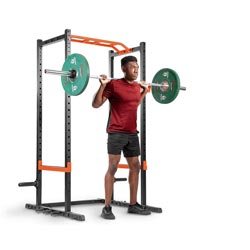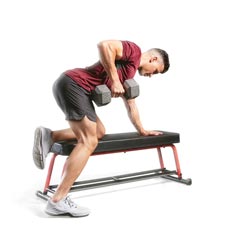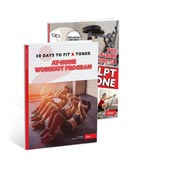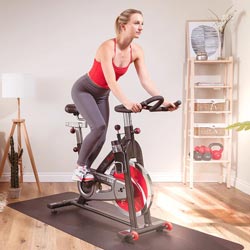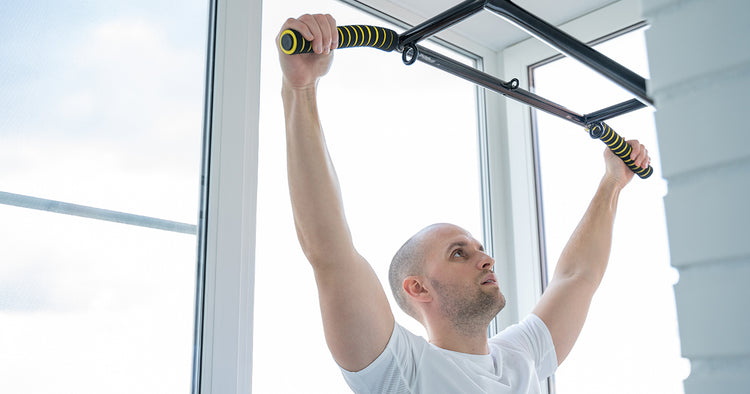Odds are, you don’t need me to tell you pull ups are one of the most challenging exercises you can do for your back and arms. Pull ups are an incredible indicator for a strong, stable, and functionally fit upper body.
If you can complete a pull up, you can gain a load of confidence in your practical strength and earn well-deserved bragging rights.
If you’re interested in putting your upper body strength to the test, perfecting your pull ups should be at the top of your to-do list!
So, ready to nail your first pull up? All you’ll need is the guide below and a pull up bar. Let’s get it!
Pull Up Muscles Targeted
During a pull up, there are a variety of upper body muscles worked. Pull ups are primarily back and upper body focused with an emphasis on the latissimus dorsi (lats), with some heavy assistance from your biceps.
Other muscles worked include your infraspinatus (part of your shoulder cuff) which will help stabilize your shoulder joint while helping to elevate and depress your shoulders, and your lower trapezius (traps) will help to pull your shoulders back and down.
Finally, your core - specifically your erector spinae (lower back), abdominals, obliques, and even glutes work together to help you maintain proper body positioning, posture, and stability during each rep.
How to Do a Pull Up
Completing your first pull up is a huge accomplishment! Below I’ve listed the steps you’ll need to properly complete your first rep.

To perform a pull up complete the following steps:
1) Grip the bar with your hands shoulder-width apart and palms facing away from you. If you need help reaching the bar you can use a box or jump up to grab the bar.
2) Hang with arms fully extended. You can bend your knees if your feet are dragging on the ground here.
3) Keep your shoulders back and core engaged as you engage your upper body to pull you up towards the bar, leading with your chest.
4) Continue pulling upwards until your chin is above the bar, pause here.
5) Slowly lower down to your starting position.
6) Repeat. Try not to swing, kick, or use your momentum to help with your reps, each rep should be even and controlled.
If you’re not yet able to complete a pull up - no biggie! There are tons of modifications, steps, tips, and tricks to help you get there. I’ve listed all the details you might need in your pull up journey below.
4 Exercises to Train for Your First Pull Up
Use these exercises as modifications to a pull up to help you work up the strength for pull ups. Or use them as supporting exercises in your routine to help you level up your pull up game. Either way, they’ll make a great addition to your workout routine.
1) Inverted Row
Inverted rows are more rhomboid, mid, and lower trapezius focused; whereas pull ups are more lat focused. What inverted rows are good for is helping to strengthen all the muscles involved in scapular retraction which is an important element of your pull up. During a pull up you want to pull from your back, which is exactly what you’re practicing during inverted rows.

To perform an inverted row, complete the following steps:
1) Grab the bar with hands facing out. Walk your feet forward so your body is at an incline.
2) Hang from the bar with your body in a nice straight line from head to heels, core and glutes engaged, and chest proud.
3) Drive your elbows down and back to row your chest up towards the bar. Focus on using both your back and arms to row and not just your arms, you should feel your back engage here.
4) Pause at the top, slowly lower back down.
5) Do not lose tension at the bottom, keep your core engaged and chest proud.
6) Repeat.
You can make inverted rows easier by bending your knees and planting feet firmly on the ground. You can make them more challenging by extending your legs, flexing your feet, and supporting yourself with your heels while keeping your entire body straight and neutral as you row. The closer you are to parallel with the ground, the harder this exercise becomes.
2) Lat Pulldowns
Lat pulldowns closely replicate the range of motion and muscles used during a pull up. With lat pulldowns, you’re directly strengthening the muscle that’s most engaged during a pullup - your lats.

To perform lat pulldowns, complete the following steps:
1) Using a lat pulldown machine, or cable machine for this exercise you can either kneel, sit on a bench, or stand to complete your reps depending on your setup.
2) Grip the bar with your hands shoulder-width apart, palms facing forward, and arms extended fully overhead.
3) Pull the bar to the top of your chest, imagining you’re squeezing a pencil in between your shoulder blades.
4) Control the bar as you return to the starting position.
5) Repeat.
The wider your grip during your lat pulldown, the more you isolate your lats, but a standard or closer grip is also great for increasing upper body strength. Using a variety of grips in your training will help you make greater gains to your pull up game.
3) Jump Pull Up (or Pull Up Hold)
Jump pull ups can help you get to the top of each rep with ease. Once you get to the top you can focus on building your isometric strength at the upper range of your pull up. As you jump up, focus on holding yourself at the top of your pull up as long as you can.

To perform a jump pull up, complete the following steps.
1) Spring off the ground, grabbing the pull up bar with palms facing away from you and muscling your way up to hold your chin above the bar.
2) Hold here for as long as you can.
3) Slowly lower until your arms are fully extended overhead, in a ‘dead hang’ position.
4) Repeat.
The isometric hold is the focus of this move (not the jump). Keep in mind you can also use a bench to help get yourself into position for each rep.
As you gain strength, challenge yourself by timing yourself at the top of each rep and pushing yourself to hold for longer than before. You can also make this variation harder by relying less and less on your jump to pull yourself up.
4) Eccentric Pull Up
Eccentric pull ups (or negative pull ups) are great because they focus on controlling the lowering phase of the movement. Over time, building eccentric (lowering) strength will improve your ability to lift yourself without assistance as well.

To perform an eccentric, pull up, complete the following steps.
1) Spring off the ground, grabbing the pull up bar with palms facing away from you and muscling your way up to hold your chin above the bar.
2) Pause here for 3 seconds.
3) Slowly lower yourself, taking about 6 seconds lower until your arms are fully extended overhead, in a ‘dead hang’ position.
4) Repeat.
Your focus during eccentric pull ups should be on the lowering phase of your pull up. So, if you’d like to use a bench or plyo box to get into position on the bar will work as well and maybe be a more comfortable place to start.
5 Pull Up Form Tips
If you have completed your first pull up, that’s only the beginning of your work. Not all pull ups were created equal. Your pull up form is extremely important and translates directly to the quality of your reps, muscles worked, and strength gained over time.
Now it’s time to work on your form and build in volume so you can continue to increase strength. Below, I’ve listed some of the top things to keep on your mind during each rep and set!
1. Brace Your Core
While pull ups are upper body focused, your core plays a big role. With a properly engaged core (including abs, lower back, and even glutes) your entire body will be focused on helping you complete each rep.
By engaging your core, you’ll also increase your control, reducing any swinging or momentum you may experience between each rep, and returning the focus into your arms and lats, exactly where we want it to be.
2. Complete a Full Range of Motion
Using a full range of motion will better recruit and engage all the muscles you’re looking to work. If you’re fine with cheating - well hey, I’m not stopping you. But don’t be upset with the muscle gains you’re missing out on the other side.
With each pull up rep, start and end in a ‘dead hang’ position with arms fully extended overhead. Slowly lower from your pull up at the end of each rep to reduce impact and increase strength.
3. Pause at the Top
Pausing at the top will help you build more control with each rep you complete. Over time, that control will lead to greater strength and performance gains.
Squeeze your muscles at the top, to ensure your muscles are appropriately engaged and active before returning to your starting position.
4. Switch Up Your Grip
Switching your grip between wide, narrow, overhand, underhand, and neutral grip can help you to recruit more muscles and correct any weaknesses you may have for greater overall pull up strength.
Train with a variety of grips to establish a well-rounded pull up routine and continue challenging yourself.
5. Modify if Needed
If you can’t complete a pull up don’t sweat it! There are many pull up modifications that you can work on to help you work up to your first rep.
Start by getting used to your body weight by simply holding a ‘dead hang’ position, gripping the bar, and hanging with arms fully extended, not even worrying about pulling yourself up.
When you’re ready, you can begin to train with some exercises that will directly strengthen the muscles used to complete a pull up (shown above).
In Closing
Pull ups are an all-star exercise for upper body strength. While completing your first pull up may seem daunting, it’s totally doable with the proper tricks up your sleeve.
With the tools above, I’m confident you have everything you need to achieve your first pull up. Mark my words, with a little bit of work you’ll be repping out pull ups in no time!

